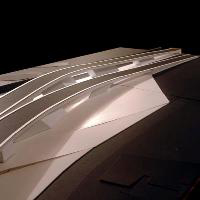A Metropolitan Bridge in Naples - Capodichino
DOI:
https://doi.org/10.6092/1970-9870/210Abstract
The project of completing the road connecting the East Naples junction of the belt-way, the 167 of Secondigliano and the outer ring road entails to build slip ramps to connect with Viale Comandante Umberto Maddalena starting from the present interruption of the work in correspondence of the standing abutment D, and to organize the relevant outer areas. This very important link road for city viability covers a crucial area of the city, for history and morphology, and can represent a real opportunity of its recovery, of urban and functional recovery, with positive effects on the whole district and beyond. The aim of the suggested project consists in making the completion of the standing bridge become an element of urban quality as well as the missing piece of the metropolitan viability mosaic. Accordingly the bridge becomes an important element of metropolitan urban landscape, its perception of an element belonging to the context, the positive environmental impact. The project is based on the idea of dynamism enhanced by the very leaning piers on which the ramps seem to plane. Therefore, the peculiarity of the area under intervention, its strategic localization in the general urban planning design, the geometries characterizing the area, its structural rule are the basic elements of the new project: a contemporary urban sign, projected into the future, strongly rooted in the past. A rare positive scenario of project targets convergence of project targets, administrative aims as well as will of realization, which should always characterize those unavoidable crucial urban transformations in order to follow the only one practicable direction: the future; the project gets again possession of the decayed area to make a new piece of city rise. Every project arises from a research on the spirit of place, and in this case the urban and natural context, although decayed, is strong. The new architecture can preserve and sustain the identity of places, which forces to think about the need for making projects inside the context without uncritically superimposing on the combination of nature and urban transformation, which has produced, in the course of time, what we call urban landscape now. The difference lies in the knowledge, in the recognizing of places, of the signs left on territory by man and of their interrelations; it lies in appreciating the values of city and urban life, in planning urban transformations, being aware that this stratified territory represents a resource for the project. The identity and recognisability of landscape represent, then, a basic element of the quality of places and are strictly connected with the improvement in the quality of life.Downloads
References
C. De Seta, Le città nella storia d’Italia, Napoli, Laterza 1981
S. Loffredo, Secondigliano da documenti inediti, Aldo Fiory Editore, Napoli 1972

Downloads
Additional Files
Published
How to Cite
Issue
Section
License


